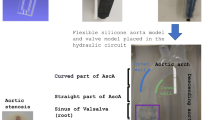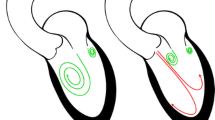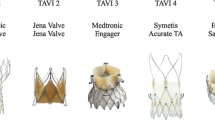Abstract
Transcatheter aortic valve implantation (TAVI) has become the alternative procedure to high-risk patients who are diagnosed with aortic valve stenosis. Differently from the traditional open-chest surgical procedure, a small variation on the prosthetic aortic valve deployment angle is expected with the TAVI procedure. The hemodynamic patterns of the blood flow in the ascending aorta are related to the development of many cardiovascular diseases. There are, however, few data available in the literature correlating the aortic valve tilt angle to hemodynamic effects. In this work, a 3D printed aorta model made of a transparent silicon resin was produced, based on the anatomy of a specific patient submitted to a TAVI procedure. The stereoscopic Particle Image Velocimetry technique was employed to measure three-component velocity fields at closely spaced cross-sectional planes, along the ascending aorta. The measurements were performed for a constant flow rate corresponding to the peak of the systolic phase of the cardiac cycle. Averaged velocity fields and turbulent quantities were determined for both, the base case, with no valve tilt, and for cases with an inclination of 4° and 8°, oriented at the four anatomical directions of the human body reference system, namely anterior, posterior, right and left. The results revealed the dominant flow patterns in the ascending aorta formed by a jet-like inlet flow impinging on the curved aorta right wall, inducing a significant eccentricity on the axial velocity profile. Regions of reverse flow were identified and linked to the abrupt area change associated with the typical reduced inlet diameter of TAVI implants. The impinging flow and wall curvature effects established circulation patterns defining a helical flow structure. The influence of the inlet flow orientation on the flow turbulent characteristics was assessed by the spatial evolution of the turbulent kinetic energy (TKE), Reynolds and viscous stresses. The maximum values of TKE were found around the inlet jet boundaries and concentrated in the neighborhood of the right aorta wall where the eccentric axial flow prevailed. Spatial distributions of the maximum Reynolds stresses were similar to the TKE distributions and presented maximum stresses typically one order of magnitude higher than the maximum average viscous shear stresses. Maximum average viscous stress distributions were revealed at the jet-like flow boundaries and in the vicinity of the right wall, displaying moderate stress levels that, according to the literature, can be sufficient to produce cell damage and platelet activation. The complex nature of the flow field was revealed by streamlines obtained from the measured flow fields, allowing the identification of the influence of the inlet flow orientation and tilt angle on the position of the stagnation point on the aorta right wall, as well as the angle of incidence of the jet-like flow on the wall. A simple model based on momentum balance was used to estimate the pressure increment on the wall due to flow impingement. The model captured the influence of the inlet flow orientation, indicating that pressure increases of the order of 40% in relation to the base case condition were obtained for the 8°, left inlet flow orientation.
Graphic abstract























Similar content being viewed by others
References
Alastruey J, Xiao N, Fok H, Schaeffter T, Figueroa CA (2016) On the impact of modelling assumptions in multi-scale, subject-specific models of aortic hemodynamics. J R Soc Interface 13:20160073
Azevedo BA, Azevedo LFA, Nunes R, Nóbrega AC (2015) In vivo blood velocity measurements with particle image velocimetry in echocardiography using spontaneous contrast. J Braz Soc Mech Sci Eng 37(2):559–569
Becsek B, Pietrasanta L, Obrist D (2020) Turbulent systolic flow downstream of a bioprosthetic aortic valve: velocity spectra, wall shear stresses, and turbulent dissipation rates. Front Physiol. https://doi.org/10.3389/fphys.2020.577188
Bissell MM, Hess AT, Biasiolli L, Glaze SJ, Loudon M, Pitcher A, Davis A, Prendergast B, Markl M, Barker AJ, Neubauer S (2013) Aortic dilation in bicuspid aortic valve disease: flow pattern is a major contributor and differs with valve fusion type. Circ Cardiovasc Imaging 6(4):499–507
Bjorkquist DC (2002) Stereo PIV calibration verification. In: 11th international symposium on applications of laser techniques to fluid mechanics, Lisbon, Portugal, 8–11 July
Buchmann N, Atkinson C, Jeremy M, Soria J (2011) Tomographic particle image velocimetry investigation of the flow in a modeled human carotid artery bifurcation. Exp Fluids 50:1131–1151
Celis D, Gomes BAA, Ibanez I, Azevedo PN, Teixeira PS, Nieckele AO (2020) Prediction of stress map in ascending aorta-optimization of the coaxial position in transcatheter aortic valve replacement. Arquivos Brasileiros de Cardiologia. https://doi.org/10.36660/abc.20190385
Chen Q, Zhong Q, Qi M, Wang X (2015) Comparison of vortex identification criteria for planar velocity fields in wall turbulence. Phys Fluids 27(8):085–101
Condemi F, Campisi S, Viallon M, Troalen T, Xuexin G, Barker AJ, Avril S (2017) Fluid-and biomechanical analysis of ascending thoracic aorta aneurysm with concomitant aortic insufficiency. Ann Biomed Eng 45(12):2921–3293
Cribier A, Eltchaninoff H, Bash A, Borenstein N, Tron C, Bauer F, Derumeaux G, Anselme F, Laborde F, Leon MB (2002) Percutaneous transcatheter implantation of an aortic valve prosthesis for calcific aortic stenosis: first human case description. Circulation 106:3006–3008
Chakraborty P, Balachandar S, Adrian RJ (2005) On the relationships between local vortex identification schemes. J Fluid Mech 535:189
Christensen KT, Adrian RJ (2001) Statistical evidence of hairpin vortex packets in wall turbulence. J Fluid Mech 431:433
Farag ES, Vendrik J, van Ooij P, Poortvliet QL, van Kesteren F, Wollersheim LW, de Mol BAJM (2019) Transcatheter aortic valve replacement alters ascending aortic blood flow and wall shear stress patterns: a 4D flow MRI comparison with age-matched, elderly controls. Eur Radiol 29(3):1444–1451
Fernandes LS, Martins FJWA, Azevedo LFA (2018) A technique for measuring ensemble-averaged, three-component liquid velocity fields in two-phase, gas–liquid, intermittent pipe flows. Exp Fluids 59(10):1–18
Frydrychowicz A, Stalder AF, Russe MF, Bock J, Bauer S, Harloff A, Berger A, Langer M, Hennig J, Markl M (2009) Three-dimensional analysis of segmental wall shear stress in the aorta by flow-sensitive four-dimensional-MRI. J Magn Reson Imaging 30:77–84
Ganong WF, Barrett KE (2005) Review of medical physiology, vol 21. McGraw-Hill Medical, NY
Ge L, Dasi LP, Sotiropoulos F, Yoganathan AP (2008) Characterization of hemodynamic forces induced by mechanical heart valves: Reynolds vs. viscous stresses. Ann Biomed Eng 36(2):276–297
Ghista DN, Kabinejadian F (2013) Coronary artery bypass grafting hemodynamics and anastomosis design: a biomedical engineering review. Biomed Eng Online 12(1):1–28
Goleski PJ, Reisman M, Don CW (2018) Reversible thrombotic aortic valve restenosis after valve-in-valve transcatheter aortic valve replacement. Catheter Cardiovasc Interv 91(1):165–168
Gomes BAA, Camargo GC, Santos JRL, Azevedo LFA, Nieckele AO, Siqueira-Filho AG, Oliveira GMM (2017) Influence of the tilt angle of percutaneous aortic prosthesis on velocity and shear stress fields. Arq Bras Cardiol 109:231–240
Groves EM, Falahatpisheh A, Su JL, Kheradvar A (2014) The effects of positioning of transcatheter aortic valve on fluid dynamics of the aortic root. ASAIO J Am Soc Artif Intern Organs 60:545
Gunning PS, Saikrishnan N, McNamara LM, Yoganathan AP (2014) An in vitro evaluation of the impact of eccentric deployment on transcatheter aortic valve hemodynamics. Ann Biomed Eng 42:1195–1206
Jeong J, Hussain F (1995) On the identification of a vortex. J Fluid Mech 285:69–94
Johnson EL, Wu MC, Xu F, Wiese NM, Rajanna MR, Herrema AJ, Hsu MC (2020) Thinner biological tissues induce leaflet flutter in aortic heart valve replacements. Proc Natl Acad Sci 117(32):19007–19016
Ha H, Kim GB, Kweon J, Lee SJ, Kim YH, Kim N, Yang DH (2016) The influence of the aortic valve angle on the hemodynamic features of the thoracic aorta. Sci Rep 6:32316
Hasler D, Landolt A, Obrist D (2016) Tomographic PIV behind a prosthetic heart valve. Exp Fluids 57(5):80
Hasler D, Obrist D (2018) Three-dimensional flow structures past a bio-prosthetic valve in an in-vitro model of the aortic root. PLoS ONE 13(3):e0194384
Hatoum H, Yousefi A, Lilly S, Maureira P, Crestanello J, Dasi LP (2018) An in vitro evaluation of turbulence after transcatheter aortic valve implantation. J Thorac Cardiovasc Surg 156(5):1837–1848
Hatoum H, Dollery J, Lilly SM, Crestanello JA, Dasi LP (2019) Sinus hemodynamics variation with tilted transcatheter aortic valve deployments. Ann Biomed Eng 47(1):75–84
Ibanez I, de Azevedo GBA, Nieckele AO (2020) Effect of percutaneous aortic valve position on stress map in ascending aorta: a fluid-structure interaction analysis. Artif Organs. https://doi.org/10.1111/aor.13883
International Organization for Standardization ISO (2018) Guide to the Expression of Uncertainty in Measurement
Katritsis D, Kaiktsis L, Chaniotis A, Pantos J, Efstathopoulos EP, Marmarelis V (2007) Wall shear stress: theoretical considerations and methods of measurement. Prog Cardiovasc Dis 49:307–329
Kim HB, Hertzberg J, Lanning C, Shandas R (2004) Noninvasive measurement of steady and pulsating velocity profiles and shear rates in arteries using echo PIV: in vitro validation studies. Ann Biomed Eng 32:1067–1076
Leo HL, Dasi LP, Carberry J, Simon HA, Yoganathan AP (2006) Fluid dynamic assessment of three polymeric heart valves using particle image velocimetry. Ann Biomed Eng 34(6):936–952
Lim W, Chew Y, Chew T, Low H (1994) Particle image velocimetry in the investigation of flow past artificial heart valves. Ann Biomed Eng 22:307–318
Markl M, Frydrychowicz A, Kozerke S, Hope M, Wieben O (2012) 4D Flow MRI. J Magn Reson Imaging 36:1015–1036
Mendis S, Puska P, Norrving B, Organization WH et al (2011) Global atlas on cardiovascular disease prevention and control. World Health Organization, Geneva
Motomiya M, Karino T (1984) Flow patterns in the human carotid artery bifurcation. Stroke 15(1):50–56
Raffel M, Willert CE, Scarano F, Kähler CJ, Wereley ST, Kompenhans J (2018) Particle image velocimetry: a practical guide. Springer, New York
Salmonsmith JA, Ducci A, Burriesci G (2019) Does transcatheter aortic valve alignment matter? Open Heart. 6:e001132. https://doi.org/10.1136/openhrt-2019-001132
Sciacchitano A (2019) Uncertainty quantification in particle image velocimetry. Meas Sci Technol 30(9):092001
Sciacchitano A, Wieneke B (2016) PIV uncertainty propagation. Meas Sci Technol 27(8):084006
Soloff SM, Adrian RJ, Liu Z-C (1997) Distortion compensation for generalized stereoscopic particle image velocimetry. Meas Sci Technol 8(12):1441–1454
Sotiropoulos F, Le TB, Gilmanov A (2016) Fluid mechanics of heart valves and their replacements. Annu Rev Fluid Mech 48:259–283
Querzoli G, Satta V, Matta G, Ferrari S, Badas MG, Pibiri M, Sica E, Bitti G (2019) In vitro fluid dynamic measurements as a support of the cardiovascular Patient Specific Diagnosis. In: 13th international symposium on particle image velocimetry, Munich, Germany, 22–24 July
Tamburino C, Barbanti M, D’Errigo P, Ranucci M et al (2015) 1-year outcomes after transfemoral transcatheter or surgical aortic valve replacement: results from the Italian observant study. J Am Coll Cardiol 66:804–812
Trauzeddel RF, Löbe U, Barker AJ, Gelsinger C, Butter C, Markl M, Schulz-Menger J, von Knobelsdorff-Brenkenhoff F (2016) Blood flow characteristics in the ascending aorta after TAVI compared to surgical aortic valve replacement. Int J Cardiovasc Imaging 32:461–467
Vester AK, Örlü R, Alfredsson PH (2016) Turbulent flows in curved pipes: recent advances in experiments and simulations. Appl Mech Rev. https://doi.org/10.1115/1.4034135
Vétel J, Garon A, Pelletier D, Farinas MI (2008) Asymmetry and transition to turbulence in a smooth axisymmetric constriction. J Fluid Mech 607:351–386
von Knobelsdorff-Brenkenhoff F, Trauzeddel RF, Barker AJ, Gruettner H, Markl M, Schulz-Menger J (2014) Blood flow characteristics in the ascending aorta after aortic valve replacement—a pilot study using 4D-flow MRI. Int J Cardiol 170(3):426–433
Wieneke B (2005) Stereo-PIV using self-calibration on particle images. Exp Fluids 39:267–280
Woo YR, Williams WP, Yoganathan AP (1983) In-vitro fluid dynamic characteristics of the abiomed trileaflet heart valve prostheses. J Biomed Eng 105:337–345
Zadrazil I, Corzo C, Voulgaropoulos V, Markides CN, Xu XY (2020) A combined experimental and computational study of the flow characteristics in a Type B aortic dissection: effect of primary and secondary tear size. Chem Eng Res Des 160:240
Acknowledgements
The authors acknowledge the agencies CAPES from the Brazilian Ministry of Education, and CNPq from the Brazilian Ministry of Science and Technology for the continued financial support. The help from the undergraduate student Mike Valente during the long measurement campaigns is also acknowledged.
Author information
Authors and Affiliations
Corresponding author
Additional information
Publisher's Note
Springer Nature remains neutral with regard to jurisdictional claims in published maps and institutional affiliations.
Appendices
Appendix
Appendix A: Experimental uncertainty estimation
The experimental standard uncertainty for a generic measured quantity X was estimated by combining the random and systematic components of the uncertainty, also known as type A and type B uncertainty components, according to ISO-GUM (2018) as,
The uncertainty on each velocity component was estimated by neglecting the contributions of the uncertainties from the image calibration and light pulse interval, as compared to the uncertainty on the particle displacement calculation (Sciacchitano and Wieneke 2016; Sciacchitano 2019; Raffel et al. 2018). The uncertainties on the fluid density and viscosity were not considered. The type A uncertainty on the velocity components was estimated from the standard deviation of the velocity measurements as (Sciacchitano and Wieneke 2016),
and similarly for \(U_{{\overline{v},A}}\) and \(U_{{\overline{w},A}}\). N is the number on uncorrelated measured samples: 1500 in the present experiments.
The systematic or type B component of the uncertainty was estimated by calibration experiments using a similar SPIV setup and processing software (Fernandes et al. 2018), leading to an uncertainty of ± 0.008 m/s for the in-plane components. The out-of-plane component displayed a larger uncertainty due to the stereoscopic displacement calculation, ± 0.014 m/s. The combined standard uncertainties on the velocity components were obtained by using Eq. (9).
The type A uncertainty components of diagonal and off-diagonal terms of the Reynolds stress tensor, Rww and Ruw were estimated by Sciacchitano and Wieneke (2016) as,
where \(\gamma_{uw}\) is the cross-correlation coefficient between u and v. The type B uncertainty on the Reynolds stress components were estimated based on the density and the uncertainty on each velocity component, since calibration experiments were not available for those quantities. For a diagonal and an off-diagonal component, these conservative estimates were computed as \(\rho \overline{{U_{w}^{2} }}\) and \(\rho \sqrt {\overline{{U_{u}^{2} }} \ \overline{{U_{w}^{2} }} }\), respectively. The combined standard uncertainty on a Reynolds stress tensor component was obtained by Eq. (9).
The type A uncertainty on the turbulent kinetic energy was computed as Sciacchitano and Wieneke (2016),
The type B uncertainty on the TKE measurements was estimated as \(\rho \overline{{U^{2} }}\), where U is the square-root combination of the uncertainties on the three velocity components. The combined standard uncertainty on TKE was obtained using Eq. (9).
The uncertainty on the components of the shear stress tensor was estimated assuming equal and non-correlated uncertainties for the neighboring velocity components involved in the spatial derivatives (Sciacchitano and Wieneke 2016). Thus,
where \(\gamma \left( {2d} \right)\) is the normalized cross-correlation coefficient of the measurement error at the two points separated from two grid spaces, 2d (derivative by central difference scheme). U is the uncertainty on the velocity measurements assumed to have the same magnitude for each component. The type B uncertainty on the shear stress measurements was estimated by propagating the uncertainties on the equations defining each shear stress tensor component, as exemplified in equation Eq. 5 for the \(\tau_{yx}\) component (ISO-GUM 2018). Uncertainties on the velocity components and displacements were considered, while the uncertainty on the fluid viscosity was neglected. The combined standard uncertainty on each shear stress tensor component was obtained using Eq. (9).
The combined standard uncertainties estimated as described above were expanded to be associated with a 95% confidence level by using a coverage factor k = 2, obtained from a t-student distribution corresponding to a large number of measurement samples (ISO-GUM 2018).
A sample calculation of the uncertainty estimates obtained following the procedure described is presented in Table 2. It is interesting to note in the data displayed in Table 2 that the type B uncertainties dominate the combined uncertainties for the measurements of the three components of the average velocity vector, due to the large amount of independent samples N used in the present work. For the Reynolds stress tensor components and the turbulent kinetic energy, the type A uncertainty components dominate. For the shear stress tensor components, both type A and B uncertainty components have equivalent influence on the combined uncertainty estimate.
Appendix B: Spatial distribution of maximum Reynolds stress
Rights and permissions
About this article
Cite this article
Bessa, G.M., Fernandes, L.S., Gomes, B.A.A. et al. Influence of aortic valve tilt angle on flow patterns in the ascending aorta. Exp Fluids 62, 113 (2021). https://doi.org/10.1007/s00348-021-03199-3
Received:
Revised:
Accepted:
Published:
DOI: https://doi.org/10.1007/s00348-021-03199-3





